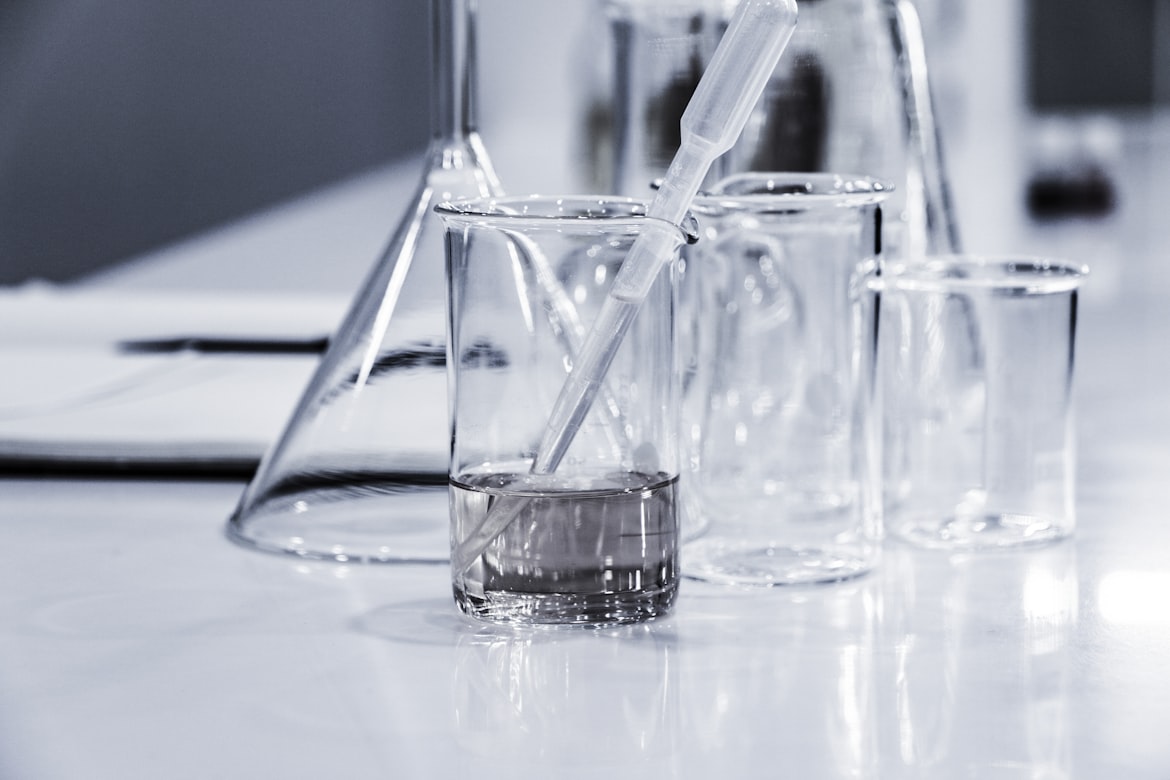The Phosphate Key
How Nature's Tiny Molecules Forge Brighter Quantum Dots
Article Navigation
Introduction: The Green Nano-Revolution
Imagine turning toxic metals into glowing nanocrystals using biological molecules found in every cell—all without extreme heat, toxic solvents, or explosive gases. This isn't science fiction; it's biomimetic nanotechnology, where scientists harness cellular machinery to build quantum dots (QDs): semiconductor particles just 2–12 nm wide that emit dazzling, tunable light.

Biomimetic nanotechnology harnesses nature's processes to create advanced materials.

Quantum dots emit vibrant colors based on their size due to quantum confinement effects.
1. Quantum Dots Decoded: Why Size Matters
Quantum dots are nanocrystals of semiconductors (e.g., cadmium sulfide, CdS) whose optical properties defy classical physics. When shrunk to nanoscale:
- Quantum confinement occurs: Electrons are squeezed into discrete energy levels, turning CdS from yellow bulk powder into color-tunable emitters (450–700 nm) 1 5 .
- A 3 nm CdS dot glows blue; at 6 nm, it shifts to red. This size-dependent fluorescence makes QDs ideal for solar cells, bioimaging, and sensors 4 7 .
The Challenge: Conventional synthesis requires 300°C, oxygen-free chambers, and toxic precursors like dimethylcadmium. Biomimetic methods, however, use living cells or cell-inspired chemistry at room temperature—and phosphorylated molecules hold the key.
2. The Phosphate Trigger: Nature's H₂S Release Agent
Phosphates (PO₄³⁻) and phosphorylated biomolecules (e.g., ATP, glucose-6-phosphate) are cellular energy carriers. Surprisingly, they also drive QD formation by liberating H₂S—the sulfur source for CdS crystals. Here's how:
The Chemical Alchemy
- Phosphates act as weak bases, deprotonating thiol groups in cysteine or glutathione. This triggers H₂S release:
- Freed H₂S then reacts with cadmium ions (Cd²⁺), forming CdS nuclei that grow into QDs.
Biological Advantage
In cells, phosphorylated metabolites like fructose-1,6-biphosphate or adenosine monophosphate (AMP) perform dual roles:
- Promote Cd²⁺ uptake into bacteria (e.g., E. coli).
- Accelerate H₂S generation from cellular thiols 1 6 .
Fun Fact: One experiment showed phosphate-mediated QD synthesis works at pH 7 and 25°C—conditions as gentle as a human cell 1 .
Traditional vs Biomimetic Synthesis
| Parameter | Traditional | Biomimetic |
|---|---|---|
| Temperature | 300°C | 25°C |
| Solvents | Toxic organics | Water |
| Precursors | Dimethylcadmium | Cysteine, phosphates |
| Energy Use | High | Low |

3. Inside a Landmark Experiment: From Bacteria to Nanocrystals
A pivotal 2017 study (RSC Advances) demonstrated phosphate-powered QD synthesis in biomimetic and living systems 1 . Let's dissect their approach:
Methodology: Simplicity as Innovation
- Mixed CdCl₂ + thiols (cysteine/glutathione) + phosphate source (e.g., inorganic phosphate, AMP, glucose-6-phosphate).
- Incubated at 25°C, pH 7, with air exposure.
- Fed bacteria CdCl₂ and phosphate sources.
- Monitored intracellular QD formation via fluorescence.
Results & Analysis: Precision at Nanoscale
- Emission Control: QDs emitted light from blue to red (450–700 nm), tuned by phosphate concentration and reaction time.
- Structural Perfection: Cubic-phase nanocrystals of 4–12 nm formed, coated with phosphate-thiol shells for stability 1 5 .
- Biosynthesis Boost: In E. coli, phosphate doubled QD yield by enhancing Cd²⁺ uptake and H₂S supply (Table 1).
| Phosphate Trigger | QD Size (nm) | Peak Emission (nm) | Synthesis Efficiency |
|---|---|---|---|
| Inorganic Phosphate (Pi) | 4.2 ± 0.8 | 480 | 100% (Reference) |
| Glucose-6-Phosphate | 5.1 ± 1.2 | 520 | 98% |
| Adenosine Monophosphate (AMP) | 7.3 ± 1.5 | 610 | 95% |
| None (Control) | No QDs formed | – | 0% |
Why This Matters: This proved cellular metabolites could replace synthetic bases (like NaOH) in QD production—enabling greener chemistry 1 2 .
4. Beyond the Lab: Extremophiles and Solar Cells
Phosphate-driven synthesis isn't limited to mild conditions. Nature's innovators—extremophiles—push boundaries:
- Dead Sea isolate Halobacillus DS2 synthesizes CdS QDs in 22% NaCl (6× seawater salinity).
- QDs contain cysteine-NaCl shells, enabling fluorescence in high salt—a feat chemically made QDs can't match 6 .
- Pedobacter UYP1, from Antarctic rocks, produces extracellular CdS QDs using H₂S from cysteine.
- When used in quantum dot-sensitized solar cells (QDSSCs), they achieved 162 mV open-circuit voltage—proving real-world potential 7 .
| QD Source | Cell Voltage (mV) | Current Density (mA/cm²) | Efficiency (%) |
|---|---|---|---|
| Pedobacter UYP1 (Antarctic) | 162 | 0.0110 | 0.0016 |
| Halobacillus DS2 (Dead Sea) | 155* | 0.0102* | 0.0013* |
| Chemical Synthesis | 175 | 0.0150 | 0.0020 |
5. The Scientist's Toolkit: Essential Reagents for Biomimetic QDs
Here's what researchers use to replicate nature's quantum factories:
| Reagent | Function | Natural Analogue |
|---|---|---|
| Cadmium Chloride (CdCl₂) | Supplies Cd²⁺ ions for crystal lattice | Environmental/industrial Cd²⁺ |
| L-Cysteine / Glutathione | Thiol source for H₂S release & QD capping | Cellular antioxidants |
| Inorganic Phosphate (Pi) | Base catalyst for H₂S generation | Bone minerals, ATP |
| Adenosine Monophosphate | Dual role: phosphate donor + organic template | Cellular energy currency |
| Mercaptosuccinic Acid | Thiol stabilizer for size-controlled QDs | Synthetic mimic of cysteine |
| Na₂S | Direct S²⁻ source (non-thiol alternative) | Volcanic/geothermal sources |
6. Future Frontiers: From Pesticide Sensors to Cancer Imaging
The phosphate-H₂S pathway isn't just efficient—it enables applications impossible with traditional QDs:
Glyphosate Sensors
Chitosan-CdS nanocomposites turn on fluorescence upon detecting glyphosate (a common pesticide) at 1 µg/mL—critical for environmental monitoring 5 .
Salt-Stable Bioimaging
Halobacillus QDs resist precipitation in bodily fluids, enhancing tumor targeting 6 .
Low-Cost Solar Tech
Pedobacter QDs slash production costs for solar cells by 60% 7 .
Conclusion: Biology as the Ultimate Nanoengineer
Phosphorylated molecules exemplify nature's elegance: turning cellular waste (thiols) and toxic metals into functional jewels. By decoding phosphate-driven H₂S release, scientists are pioneering QDs that merge performance with sustainability—proving that in nanotechnology, green doesn't mean compromise. As one researcher muses, "We're not just making nanoparticles; we're learning nature's recipe for alchemy."
Further Reading: RSC Advances (2017) 1 , Microbial Cell Factories (2021) 7 .